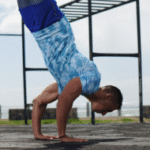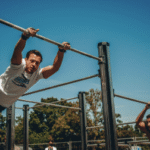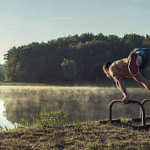Can Anyone Learn to Handstand? A Detailed Guide
The freestanding handstand is a pinnacle of bodyweight control—a skill that seems to blend strength, balance, and a touch of magic. It’s a common sight in Houston’s parks and boutique fitness studios, often leaving onlookers with the same question: “Could I ever do that?”
The immediate, and perhaps surprising, answer is: Yes, almost certainly.
The belief that handstands are reserved for elite gymnasts, yogis, or those who learned as children is a pervasive myth. A handstand is not an innate talent; it is a skill . And like any other skill, from learning to ride a bike to playing an instrument, it can be developed through a logical, patient, and consistent process. This guide will break down what it truly takes to learn a handstand and why it’s an accessible goal for almost anyone.
Deconstructing the Handstand: It’s More Than Just Balance
Mastering a handstand isn’t about having a “magical” sense of balance. It’s about systematically building three key pillars:
- The Pillar of Strength
Before you can balance, you must be able to comfortably support your own body weight. This isn’t about brute force, but about specific, functional strength.
Shoulder Strength and Stability: Your shoulders are the foundation of your handstand. You need the strength to not only hold your weight but to actively “push” the ground away, creating a stable, locked-out structure. This is built through exercises like wall-assisted handstand holds , pike push-ups , and planks .
Wrist and Forearm Resilience: Your wrists will bear the brunt of the load. A significant part of learning to handstand is conditioning the wrists through specific mobility drills and strengthening exercises to prevent injury.
Core Tension: A handstand is often described as a “plank in the air.” The ability to create and hold a rigid, hollow body line is what keeps your body straight and stable. This is developed through dedicated core work like hollow body holds .
Crucially, you don’t need to have all this strength before you start. The process of learning to handstand is what builds this specific strength.
- The Pillar of Balance
Balance is not something you either have or you don’t. It’s a neurological skill that your brain learns through practice.
Micro-Adjustments: Balancing on your hands is a constant conversation between your hands, wrists, and brain. You learn to make tiny, almost imperceptible adjustments with your fingers and palms to keep your center of gravity over your base of support.
Body Awareness (Proprioception): Through consistent practice, you develop a keen sense of where your body is in space without having to see it. You start to feel when your hips are perfectly stacked over your shoulders and wrists.
- The Pillar of Confidence (Overcoming Fear)
This is, by far, the biggest and most important hurdle for an adult learner. Your brain is hardwired to believe that being upside down is dangerous.
The Fear of Falling: Every beginner has it. The fear of kicking up too hard and toppling over is a powerful inhibitor that causes hesitation and poor form.
The Solution – Learning to Fall: A structured handstand program, especially in a class setting, addresses this on day one. You will learn how to safely exit a handstand by “bailing out” into a simple cartwheel. By practicing how to fall in a controlled way, you remove the fear. When the fear is gone, your body is free to learn without hesitation.
Addressing the Common “Buts…”
“But I’m not in shape.” You don’t get in shape for the handstand; the handstand gets you in shape. The foundational conditioning drills will build the strength you need as you go.
“But I’m too old.” While a younger person might build strength faster, age is not a disqualifier. Many people learn to handstand in their 30s, 40s, 50s, and beyond. The journey might require a greater focus on mobility and a more patient approach to conditioning, but the principles remain the same.
“But I’m not flexible enough.” While extreme flexibility isn’t required, good shoulder and wrist mobility is important for achieving a straight line and preventing injury. A good program will incorporate the necessary mobility work alongside the strength training.
The Key Ingredient: A Structured Process
Can anyone just kick up against a wall and hope to learn a handstand? It’s unlikely and unsafe. The key to success is following a structured, progressive plan , ideally under the guidance of a qualified coach. A coach provides the three things you can’t get from a YouTube video:
- A Personalized Path: They assess your current level and provide the exact drills you need.
- Real-Time Feedback: They are an “external eye” that can correct subtle form errors you can’t see.
- Safety and Spotting: They provide a safe environment and the physical support needed to build confidence.
Conclusion:
So, can anyone learn to handstand? With very few exceptions for specific medical conditions, the answer is a resounding yes . The handstand is not a gift reserved for the few; it is a skill earned by the persistent. It requires a commitment to building strength, a willingness to practice balance, and the courage to overcome fear. For anyone in Houston with the desire to learn, the path is clear. It’s a journey of patience and consistency, but the reward—the incredible feeling of mastering your own body in defiance of gravity—is well worth the effort.

Can Anyone Learn to Handstand? A Detailed Guide
Route
Calisthenics Gym Houston Functional Bodyweight Training
Secondary phone: (346) 483-3195
Email: info@calisthenicsclubhouston.com
URL: https://calisthenicsclubhouston.com/
Monday 6:00 AM - 7:00 PM Tuesday 6:00 AM - 7:00 PM Open now Wednesday 6:00 AM - 7:00 PM Thursday 6:00 AM - 7:00 PM Friday 12:00 PM - 6:30 PM Saturday 9:45 AM - 12:00 PM Sunday 3:00 PM - 5:00 PM





